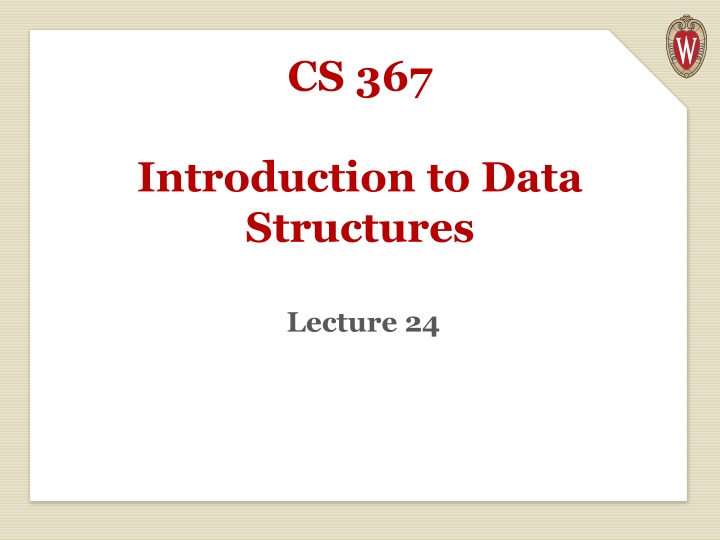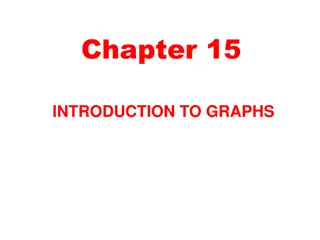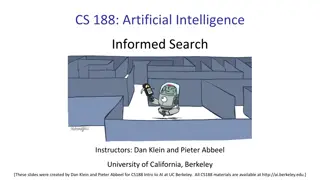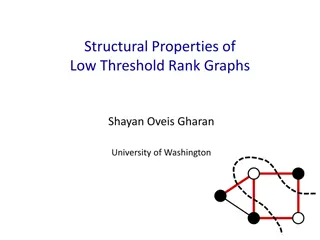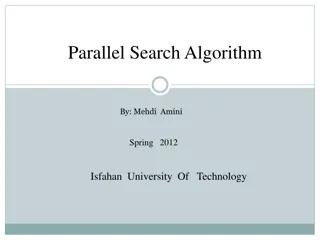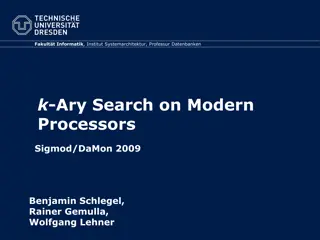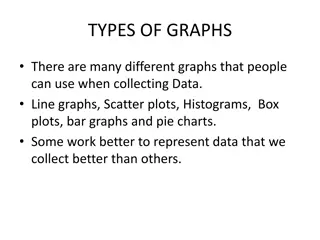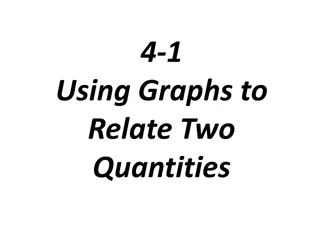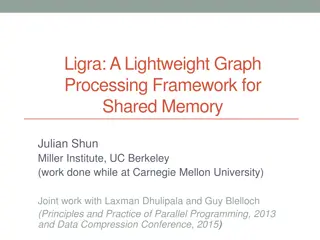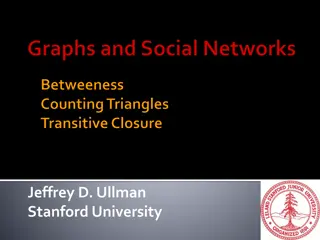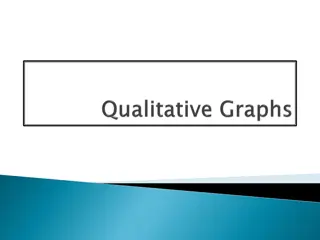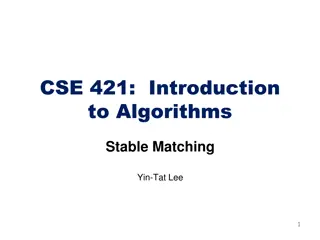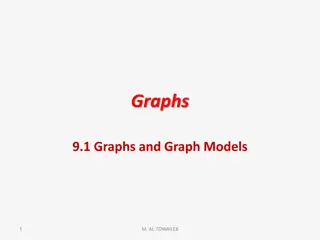Breadth-First Search Algorithm in Graphs
Today's lecture covers the Breadth-First Search algorithm, an essential technique for exploring graphs efficiently. Learn how BFS works and its application in finding the shortest path between nodes. Understand the implementation with helpful examples and insights.
Download Presentation

Please find below an Image/Link to download the presentation.
The content on the website is provided AS IS for your information and personal use only. It may not be sold, licensed, or shared on other websites without obtaining consent from the author.If you encounter any issues during the download, it is possible that the publisher has removed the file from their server.
You are allowed to download the files provided on this website for personal or commercial use, subject to the condition that they are used lawfully. All files are the property of their respective owners.
The content on the website is provided AS IS for your information and personal use only. It may not be sold, licensed, or shared on other websites without obtaining consent from the author.
E N D
Presentation Transcript
CS 367 Introduction to Data Structures Lecture 24
Todays topics: Graph Algorithms Data Structures in Computer Systems
Breadth-first Search An alternative to depth-first choice is breadth-first search. From a starting node all nodes at distance one are visited, then nodes at distance 2, etc. This sort of search is used to find the shortest path between two nodes.
Weve already seen the tree-oriented version of breadth-first search level order traversal. As in level-order traversal, we use a queue to remember nodes waiting to be fully processed. We also use a visited flag to remember nodes already processed (and queued).
public void bfs(Graphnode<T> n) { Queue<Graphnode> queue = new Queue<Graphnode>(); n.setVisited(true); queue.enqueue( n ); while (!queue.isEmpty())) { Graphnode<T> current = queue.dequeue(); for (Graphnode<T> k : current.getSuccessors()) { if (! k.getVisited()){ k.setVisited(true); queue.enqueue(k); } // end if k not visited } // end for every successor k } // end while queue not empty }
Shortest Path We can use bfs to find the shortest distance to each reachable node: add a distance field to each node when bfs is called with node n, set n's distance to zero when a node k is about to be enqueued, set k's distance to the distance of the current node (the one that was just dequeued) + 1
Shortest Weighted Path The shortest path does not always give us the best result. Consider a highway map, listing cities and distances:
Shortest path tells us the best route from Madison to Milwaukee is through Beloit, since it takes just two steps. But looking at distances tells us the route through Delafield is better. What we need is a shortest weighted path algorithm. Dijkstra s algorithm lets us compute shortest weighted paths efficiently.
Dijkstras Algorithm Dijkstra s algorithm uses an explorer approach, in which we visit nodes along various paths, always recording the shortest (or fastest, or cheapest) distance. We start at a source node. The distance from source s to itself is trivially 0.
We then look at nodes one step away from the source. Tentative distances are recorded. The smallest distance gives us the shortest path from s to one node. Why? This node is marked as finished. We next look the nearest node not marked as finished. Its successors are explored. The node marked with the shortest distance is marked as finished. Then the unfinished node with the shortest distance is explored.
The process continues until all nodes are marked as finished. Here is an outline of Dijkstra s Algorithm. We start with: A graph, G, with edges E of the form (v1, v2) and vertices (nodes) V, and a source vertex, s.
The data structures we use are: dist : array of distances from the source to each vertex prev : array of pointers to preceding vertices i : loop index F : list of finished vertices U : list or heap unfinished vertices
Initialization: F = Empty list U = All vertices (nodes) for (i = 0 ; i < U.size(); i++) { dist[i] = INFINITY; prev[i] = NULL; } dist[s] = 0; // Starting node
while (U.size() > 0) { pick the vertex, v, in U with the shortest path to s; add v to F; remove v from U; for each edge of v, (v1, v2) { if (dist[v1] + length(v1, v2) < dist[v2]) { dist[v2] = dist[v1] + length(v1, v2); prev[v2] = v1; } } }
Complexityof Dijkstras Algorithm The complexity is measured in terms of edges (E) and vertices (nodes) N. If list U is implemented as an unordered list, execution time is O(N2) Why? As each node is processed, the U list must be searched for the cheapest unfinished node.
But the U list may also be implemented as a priority queue (using a heap). Then getting the cheapest unfinished node is only log N. But each time an edge is used to update the best known distance, the priority queue may need to be restructured into heap form. This leads to O(E log N), which is usually better than O(N2).
Traveling Salesman Problem Given n cities we wish the shortest (or fastest, or cheapest) path that visits each city and returns to the starting point.
The obvious approach is to try all possible paths. But this is exponential! Perhap a generalization of Dijkstra s algorithm? No theoretical computer science tells us the best we can do most likely must be exponential.
Approximation Algorithms What if we accept something close to optimal? Christofis s algorithm guarantees a solution no worst than 50% above optimal. It is O(N3). Heuristics often improve Christofis s bound. For example, try to swap pairs of adjacent cities.
CS 577 Introduction to Algorithms Basic paradigms for the design and analysis of efficient algorithms: greed, divide-and-conquer, dynamic programming, reductions, and the use of randomness. Computational intractability including typical NP- complete problems and ways to deal with them.
Data Structures in Computer Systems Modern computers are built using integrated circuits:
These are microscopic circuits composed of transistors and wires. A single processor chip may contain over a billion transistors. Each transistor is a microscopic on/off circuit. Its output is a low (near zero) voltage or a higher voltage.
Before integrated circuits, computers were built using individual transistors, or tubes, or even relays. Computer data is represented by the binary values 0 and 1. But these are merely symbols for a transistor putting out a low (0) or high (1) voltage.
A modern computer has these parts: processor: the brain that does arithmetic, responds to incoming information, and generates outgoing information primary storage (memory or RAM): the blackboard that remembers information used by the processor. It is connected to the processor by a system bus (wiring). system and expansion busses: the transfer mechanisms (wiring plus connectors) that connect the processor to primary storage and input/output devices.
A computer usually comes with several input/output devices. For input: a keyboard, a mouse; For output, a display (monitor), a printer; For both input and output: an internal disk drive, memory key, CD reader/writer, as well as connections to external networks.
For reasons of speed, primary storage is connected more closely to the processor than are the input/output devices. Most of the devices (e.g., internal disk, printer) are themselves primitive computers that contain simple processors to help transfer information to/from the processor to/from the device.
Binary Coding The information in a computer is encoded as electrical off-on ( 0 and 1 ) pulses that travel on the bus and arrive to the processor. Here is a summary of base-2 (binary) coding of numbers, which is the concept upon which computer information is based:
number binary coding 0 0000 1 0001 2 0010 3 0011 4 0100 5 0101 6 0110 7 0111 8 1000 ... 14 1110 15 1111
It is possible to do arithmetic in base two; 3+5 is written: 0011 +0101 ----- 1000 The addition works like normal (base-10) arithmetic, where 1 + 1 = 10 (0 with a carry of 1). Subtraction, multiplication, etc., work this way, too..
Negative values Negative values can also be represented in binary. The leftmost bit is reserved as a sign bit. A 1 means negative; a 0 means positive or zero.
We create a negative value using twos complement: Take a positive value, invert each bit, then add 1. Thus since 3 is 0011, to get -3, we first flip each bit to get 1100 Then add 1 to get 1101. To see that value really is -3, lets add 3 to -3: 0011 +1101 ----- 0000
Why did we add that 1? Because we don t want two different o encodings, plus zero = 0000 and negative zero = 1111 In our encoding if we negate 0, we start with 0000, then flip bits to get 1111, Then add 1 to get 0000!
Registers A register is a high speed memory location directly attached to a processor. All arithmetic is done through registers. A register holds a sequence of bits, representing a numeric value.
Here is a picture of an 8-bit register that holds the number 9: +--+--+--+--+--+--+--+--+ | 0| 0| 0| 0| 1| 0| 0| 1| +--+--+--+--+--+--+--+--+ A processor has multiple registers, typically from 8 to 64, depending on the processor s design.
A processor would compute 3+5 by placing 3 (0000 0011) and 5 (0000 0101) into two registers and then using the wiring between the registers to compute the sum, which might be saved in a third register. A typical, modern register has 32 bits, called a fullword. Such a register can store a value in the approximate range of -2 billion to +2 billion.
The typical series of step in computing A = B + 1; is: Load B from memory into a register Add 1 to that register Store the register s updated contents into A
Central processing unit The central processing unit (CPU) is the heart of any computer. It is a very complex circuit wired to compute arithmetic operations on numbers using data registers. Here is a simplistic picture of the parts of a processor:
Its key components include: Data registers to hold numbers for computation. A simple clock --- a pulse generator -- - that helps the Control Unit do instructions in proper time steps. An arithmetic-logic unit (ALU) that does arithmetic on the numbers held in the data registers.
A control unit triggers the arithmetic operations in the ALU. How does the control unit know to request an addition or a subtraction? Simple: it obtains instructions, one at a time, that have been stored in memory. An instruction counter -- a register that tells the control unit where to find the instruction to be done.
An instruction register where an instruction is copied and held for execution by the control unit, An address buffer and data buffer -- two registers that are used when the processor wishes to write information from a register to primary storage (or read information from primary storage). An interrupt register used to handle external devices.
Processor Speed A processor's speed is measured in Hertz (a measure of frequency). It is literally the speed of the computer's internal clock; the larger the Hertz number, the faster the processor. A modern processor runs at several gigahertz. So billions of instructions per second are possible.
Primary Storage (Main Memory) Primary storage (also called random- access memory --- RAM) is a very long sequence of fullwords, representing data to be used by the processor. Here is a simple picture:
